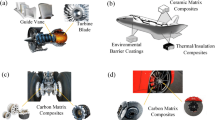Abstract
Ceramic matrix composites (CMC) are considered the next generation of advanced materials used in space and aviation due to their high-temperature strength, creep resistance, chemical resistance, low porosity, and low density. However, these materials are difficult to process owing to the large cutting force and high cost on tool consumption. electrical discharge machining (EDM), featured by the negligible machining force and acceptable tooling cost, is a potential nontraditional machining technique for CMC. In this paper, EDM was used to process a new class of advanced CMC, that is, those with continuous ceramic fiber reinforcements. The challenge is its low material removal rate (MRR) due to the low workpiece conductivity and debris evacuation efficiency. Electrode vibration and dielectric deep flushing were used to promote debris evacuation, and an increase of MRR and surface quality without sacrificing tool wear ratio was observed. Gap voltage, peak current, pulse duration, and duty ratio were studied using design of experiments for deeper understanding of the process. The effect of these parameters was investigated, and an analysis of variance was conducted. The optimal condition was also predicted and experimentally validated. It was found that a high gap voltage or low duty ratio leads to a high machining rate due to improved debris evacuation efficiency. The material removal mechanism was found to be cracking due to thermal expansion of the matrix and breakage of the nonconductive fibers.
Similar content being viewed by others
Explore related subjects
Discover the latest articles and news from researchers in related subjects, suggested using machine learning.References
Chawla KK (2003) Ceramic matrix composites, 2nd edn. Kluwer, Boston
Kumar J, Khamba JS, Mohapatra SK (2009) Investigating and modeling tool-wear rate in the ultrasonic machining of titanium. Int J Adv Manuf Tech 41(11–12):1107–1117
Tsai CH, Lin BC (2007) Laser cutting with controlled fracture and pre-bending applied to LCD glass separation. Int J Adv Manuf Tech 32(11–12):1155–1162
Liu HT, Schubert E (2009) Piercing in delicate materials with abrasive-waterjets. Int J Adv Manuf Tech 42(3–4):263–279
Kunieda M, Lauwers B, Rajurkar KP, Schumacher BM (2005) Advancing EDM through fundamental insight into the process. Cirp Ann-Manuf Techn 54(2):599–622
Rajurkar KP, Yu ZY (2000) 3D micro-EDM using CAD/CAM. Cirp Ann-Manuf Techn 49:127–130
Zhao WS, Meng QG, Wang ZL (2002) The application of research on powder mixed EDM in rough machining. J Mater Process Tech 129(1–3):30–33
Wei CJ, Xu KZ, Ni J, Brzezinski AJ, Hu DJ (2011) A finite element based model for electrochemical discharge machining in discharge regime. Int J Adv Manuf Tech 54(9–12):987–995
Clijsters S, Liu K, Reynaerts D, Lauwers B (2010) EDM technology and strategy development for the manufacturing of complex parts in SiSiC. J Mater Process Tech 210(4):631–641
Chiang K (2008) Modeling and analysis of the effects of machining parameters on the performance characteristics in the EDM process of Al2O3 + TiC mixed ceramics. Int J Adv Manuf Tech 37(5–6):523–533
Patel KM, Pandey PM, Rao PV (2010) Optimisation of process parameters for multi-performance characteristics in EDM of Al2O3 ceramic composite. Int J Adv Manuf Tech 47(9–12):1137–1147
Ghoreishi M, Atkinson J (2002) A comparative experimental study of machining characteristics in vibratory, rotary and vibro-rotary electro-discharge machining. J Mater Process Tech 120(1–3):374–384
Xu MG, Zhang JH, Li Y, Zhang QH, Ren SF (2009) Material removal mechanisms of cemented carbides machined by ultrasonic vibration assisted EDM in gas medium. J Mater Process Tech 209(4):1742–1746
Lauwers B, Kruth JP, Brans K (2007) Development of technology and strategies for the machining of ceramic components by sinking and milling EDM. Cirp Ann-Manuf Techn 56(1):225–228
Liu YH, Ji RJ, Li XP, Yu LL, Zhang HF, Li QY (2008) Effect of machining fluid on the process performance of electric discharge milling of insulating Al2O3 ceramic. Int J Mach Tool Manu 48(9):1030–1035
Fujiki M, Ni J, Shih AJ (2009) Investigation of the effects of electrode orientation and fluid flow rate in near-dry EDM milling. Int J Mach Tool Manu 49(10):749–758
Jameson EC (2001) Electrical discharge machining. Society of Manufacturing Engineers, Dearborn, MI
Bansal NP, Knovel (Firm) (2005) Handbook of ceramic composites. Kluwer, Boston
Khan AA (2008) Electrode wear and material removal rate during EDM of aluminum and mild steel using copper and brass electrodes. Int J Adv Manuf Tech 39(5–6):482–487
Yan BH, Wang CC, Liu WD, Huang FY (2006) Machining characteristics of Al2O3/6061Al composite using rotary EDM with a disklike electrode. Int J Adv Manuf Tech 16(5):322–333
Author information
Authors and Affiliations
Corresponding author
Rights and permissions
About this article
Cite this article
Wei, C., Zhao, L., Hu, D. et al. Electrical discharge machining of ceramic matrix composites with ceramic fiber reinforcements. Int J Adv Manuf Technol 64, 187–194 (2013). https://doi.org/10.1007/s00170-012-3995-5
Received:
Accepted:
Published:
Issue Date:
DOI: https://doi.org/10.1007/s00170-012-3995-5




